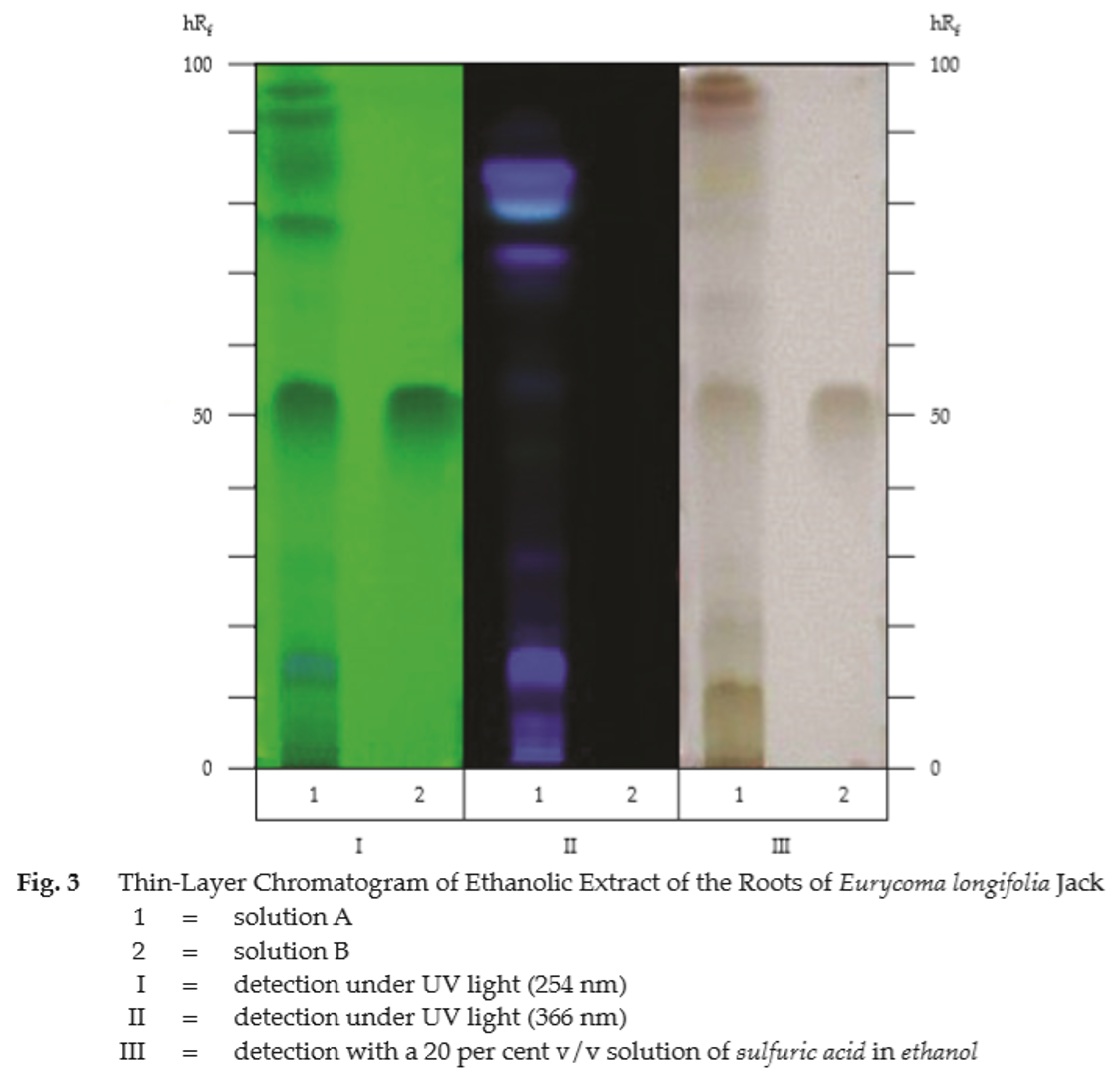ตำรามาตรฐานยาสมุนไพรไทย
Thai Herbal Pharmacopoeia
สำนักยาและวัตถุเสพติด กรมวิทยาศาสตร์การแพทย์ กระทรวงสาธารณสุข
Bureau of Drug and Narcotic, Department of Medical Sciences, Ministry of Public Health(Tinospora crispa (L.) Hook.f. & Thomson)
(Nelumbo nucifera Gaertn.)
(Centella asiatica (L.) Urb.)
(Centella Dry Extract)
(Centella Cream)
(Mesua ferrea L.)
(Piper sarmentosum Roxb.)
(Piper sarmentosum Roxb.)
(Pterocarpus santalinus L. f.)
(Santalum album L.)
(Senna tora (L.) Roxb.)
(Senna alata (L.) Roxb.)
(Senna Alata Tea)
(Piper retrofractum Vahl)
(Myristica fragrans Houtt)
(Andrographis paniculata (Burm. f.) Nees)
(Andrographis Capsules)
(Allium ascalonicum L.)
(Ocimum tenuiflorum L.)
(Curcuma longa L.)
(Turmeric Capsules)
(Turmeric Dry Extract)
(Turmeric Dry Extract Capsules)
(Arcangelisia flava (L.) Merr.)
(Curcuma sp.)
Harrisonia perforata (Blanco) Merr.
(Aristolochia pierrei Lecomte)
(Zingiber officinale Roscoe)
(Ginger Capsules)
(Ginger Tea)
(Cassia fistula L.)
(Nardostachys jatamansi (D. Don) DC.)
(Angelica sinensis (Oliv.) Diels)
Artemisia annua L.
(Ligusticum sinense Oliv. cv. Chuanxiong)
(Neopicrorhiza scrophulariiflora Pennell)
(Atractylodes lancea (Thunb.) DC.)
(Aucklandia lappa Decne)
(Terminalia chebula Retz.)
(Angelica dahurica (Hoffm.) Benth. & Hook. f. ex Franch. & Sav. var. dahurica)
(Kaempferia parviflora Wall. ex Baker)
(Hibiscus sabdariffa L.)
(Roselle Tea)
(Allium sativum L.)
(Zingiber zerumbet (L.) Sm.)
(Wurfbainia testacea (Ridl.) Škorničk.& A. D. Poulsen)
(Cannabis sativa L.)
(Myristica fragrans Houtt)
(Dracaena cochinchinensis (Lour.) S. C. Chen)
(Ficus racemosa L.)
(Hyptis suaveolens (L.) Poit.)
Clerodendrum indicum (L.) Kuntze
(Phyllanthus emblica L.)
(Citrus hystrix DC.)
(Citrus hystrix DC.)
(Areca catechu L.)
(Momordica charantia L.)
Moringa oleifera Lam.
(Aegle marmelos (L.) Corrêa)
(Solanum trilobatum L.)
(Morus alba L.)
Gynostemma pentaphyllum(Thunb.)
Makino
(Clinacanthus nutans (Burm. f.) Lindau)
(Cissus quadrangularis L.)
(Mimusops elengi L.)
(Zingiber montanum (J. König) Link. ex A. Dietr.)
(Piper betle L.)
(Capsicum annuum L.)
(Capsicum Oleoresin)
(Capsicum Gel)
(Piper nigrum L.)
(Piper nigrum L.)
(Eurycoma longifolia Jack)
(Thunbergia laurifolia Lindl.)
(Piper wallichii (Miq.) Hand.-Mazz.)
Senna garrettiana (Craib) H. S. Irwin & Barneby
(Terminalia bellirica (Gaertn.) Roxb.)
(Terminalia chebula Retz.)
(Caesalpinia bonduc (L.) H. Roxb.)
(Tarlmounia elliptica (DC.) H. Rob., S. C. Keeley, Skvaria & R. Chan)
(Hog Creeper Vine Dry Extract Capsiles)
(Hog Creeper Vine Dry Extract)
(Brachypterum scandens (Roxb.) Miq.)
(Lepidium sativum L.)
(Nigella sativa L.)
(Cuminum cyminum L.)
(Foeniculum vulgare Mill.)
(Plantago ovata Forssk.)
(Pimpinella anisum L.)
(Carum carvi L.)
(Anethum graveolens L.)
(Trachyspermum ammi (L.) Sprague)
Albizia procera (Roxb.) Benth.
(Acorus calamus L.)
(Tiliacora triandra (Colebr.) Diels)
Cyanthillium cinereum (L.) H. Rob.
(Orthosiphon aristatus (Blume) Miq.)
Murdannia loriformis (Hassk.) R. S. Rao & Kammathy
(Capparis micracantha DC.)
(Chrysopogon zizanioides (L.) Roberty)
(Cyperus rotundus L.)
(Cannabis sativa L.)
(Syzygium aromaticum (L.) Merr. & L. M. Perry)
(Boesenbergia rotunda (L.) Mansf.)
(Acanthus ebracteatus Vahl)
(Acanthus ilicifolius L.)
(Kaempferia galanga L.)
(Curcuma comosa Roxb.)
Betula alnoides Buch.-Ham. ex D. Don
Cannabis sativa L.
Carthamus tinctorius L
Mitragyna speciosa (Korth.) Havil
Mallotus repandus (Rottler) Müll. Arg
Azadirachta indica A. Juss. var. siamensis Valeton
Azadirachta indica A. Juss. var. siamensis Valeton
Punica granatum L.
Rhinacanthus nasutus (L.) Kurz
Baliospermum solanifolium (Burm.) Suresh
Curcuma aeruginosa Roxb
Boesenbergia kingii Mood & L. M. Prince
Senegalia rugata (Lam.) Britton & Rose
Acacia concinna (Willd.) DC.
Senegalia rugata (Lam.) Britton & Rose
Acacia concinna (Willd.) DC.
Senna alexandriana Mill. var. alexandriana
Cassia acutifolia Delile, Cassia angustifolia Vahl
Butea superba Roxb. ex Willd.
[Plaso superba (Roxb. ex Willd.) Kuntze, Rudolphia superba (Roxb. ex Willd.) Poir.
Pueraria candollei Graham
ex Benth. var. mirifica (Airy Shaw & Suvat.) Niyomdham
Streblus asper Lour.
Suregada multiflora (A. Juss.) Baill. (Gelonium
multiflorum A. Juss.
Longjack Root is the dried root of Eurycoma longifolia Jack (E. latifolia Ridl., E. longifolia var. cochinchinensis Pierre, E. merguensis Planch.) (Family Simaroubaceae), Herbarium Specimen Number: DMSC 5238, Crude Drug Number: DMSc 0536.
Constituents Longjack Root contains quassinoids (e.g., eurycomanone, eurycomanol, eurycomalactone, and their derivatives). It also contains β-carboline and canthin-6-one alkaloids, volatile compounds (e.g., curcumene, massoilactone), etc.
Description of the plant (Fig. 1) Shrub to treelet, 2 to 5(-10) m tall; monoecious or dioecious; stem erect, tubular, smooth; young shoot puberulous with brownish red glandular hairs. Leaves pinnately compound, spirally arranged, up to 1 m long, crowded at tip; leaflet sessile, opposite or subopposite, in one plane, lanceolate to obovate-lanceolate, rarely ovate-oblong, 5 to 10 cm long, 1.5 to 6 cm wide, apex acute or acuminate, base slightly cuneate, oblique, margin entire, subcoriaceous, dark green, nerves inconspicuous on both surfaces. Inflorescence in large panicle, axillary or terminal. Flower bisexual or unisexual, reddish; pedicel rather thick, up to 7 mm long; bract triangular, very small, about 1 mm, caducous; calyx small, 5(-6)-lobed, about 1 mm long; petals 5(-6), lanceolate to ovate or obovate-oblong, 4 to 6 mm long, 2 to 3 mm wide, puberulous on both surfaces; stamens 5(-6), 1.5 to 2.5 mm long, anther about 0.3 mm long, staminode about 0.5 mm in female flower, up to 2 mm in male flower; ovary superior, carpels 5(-6), free, style up to 3 mm long, stigma peltate, 5(-6)-lobed. Fruit up to 5 drupelets; drupelet ellipsoid or ovoid, 1 to 2 cm long, 0.5 to 1.2 cm wide, red to blackish purple when ripe; drupelet stalk about 3 mm long. Seed 1 per drupelet.
Description Odour, mild; taste, bitter.
Macroscopical (Fig. 1) Obliquely or transversely sliced root, varying in shape, length, width, and thickness, hard, light; externally, pale brown; internally, ivory with radial lines.
Microscopical (Figs. 2a, 2b, 2c, 2d) Transverse section of the root shows cork, cortex, phloem, xylem, and medullary ray. Cork, several layers of suberized rectangular cells, some containing reddish brown resinous substance. Cortex, polygonal parenchyma cells, some containing starch grains, reddish brown resinous substance or prismatic crystals, sclereids scattering throughout the cortical layer. Phloem, small thin-walled parenchyma containing small starch grains and fibres. Xylem, lignified bordered-pitted vessels, slightly lignified pitted parenchyma containing large starch grains, and fibres. Medullary ray, rectangular parenchyma of phloem rays and xylem rays with varying sizes of starch grains.
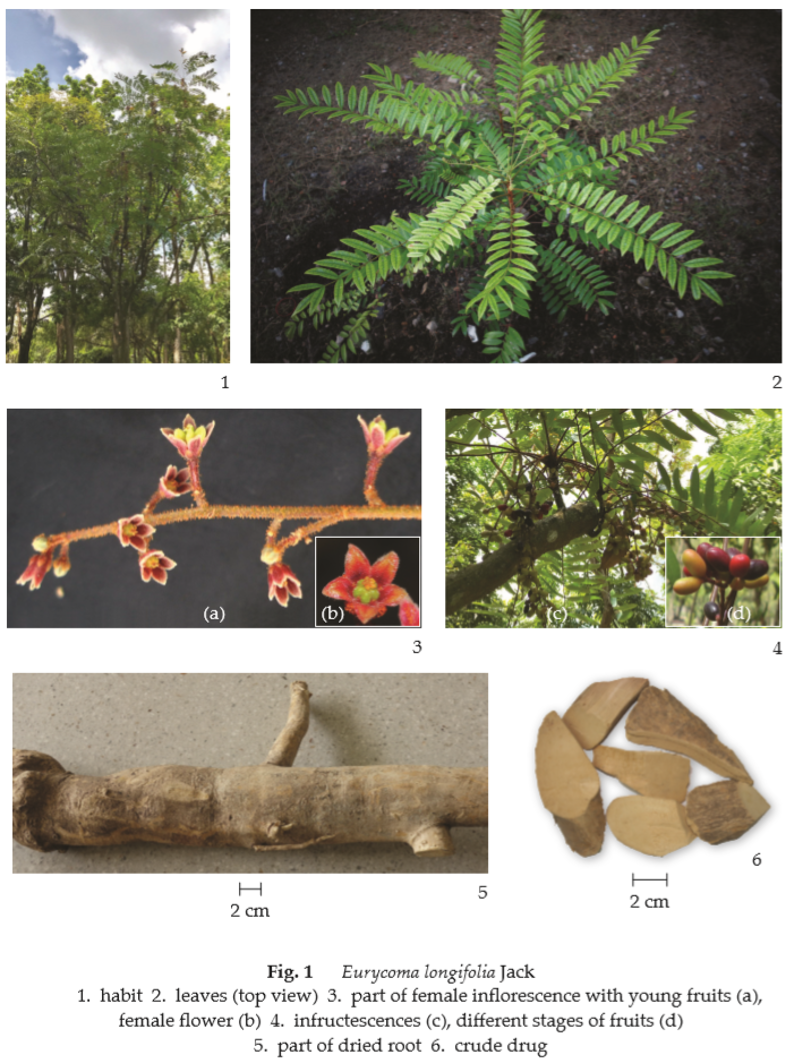
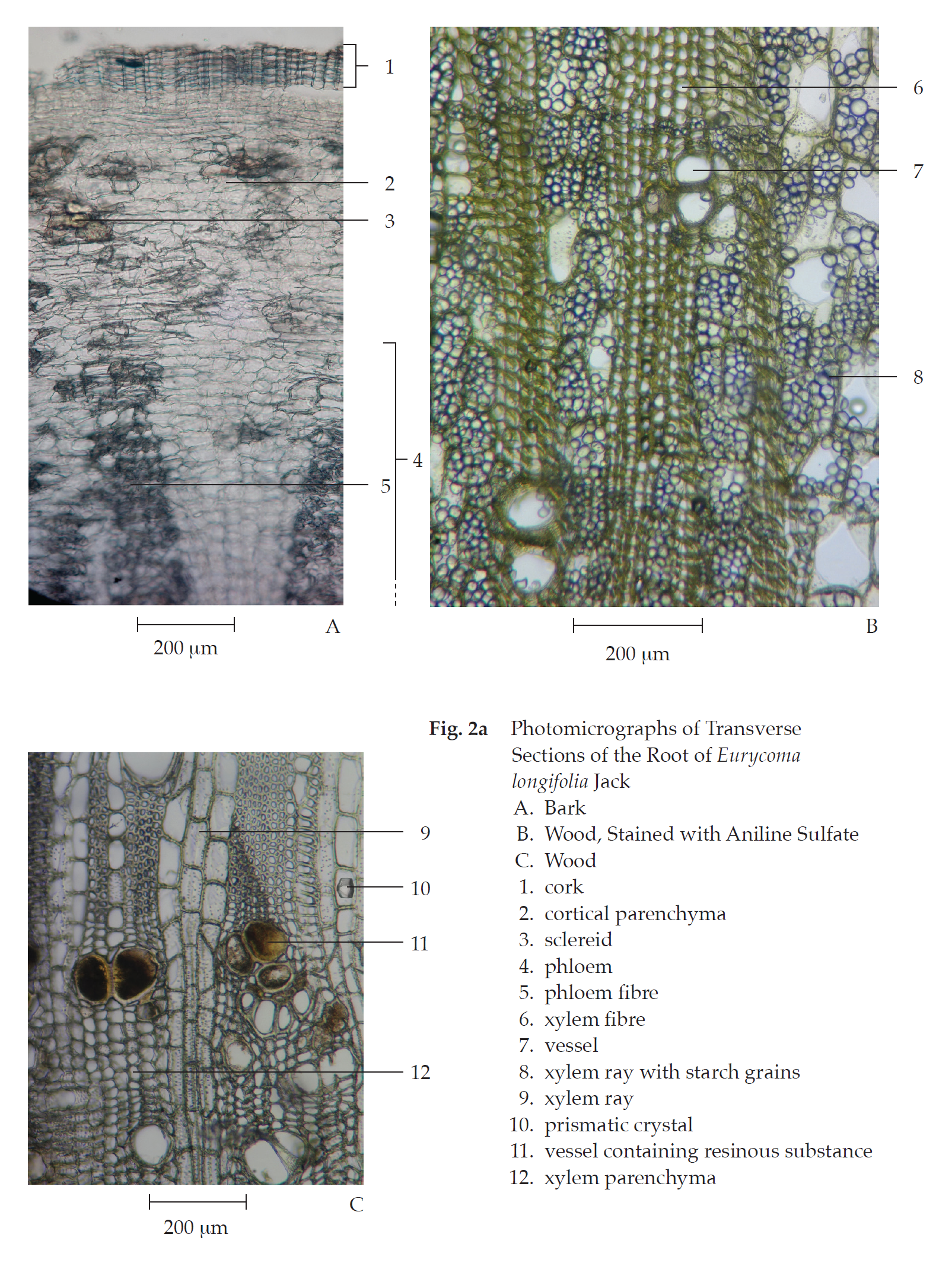
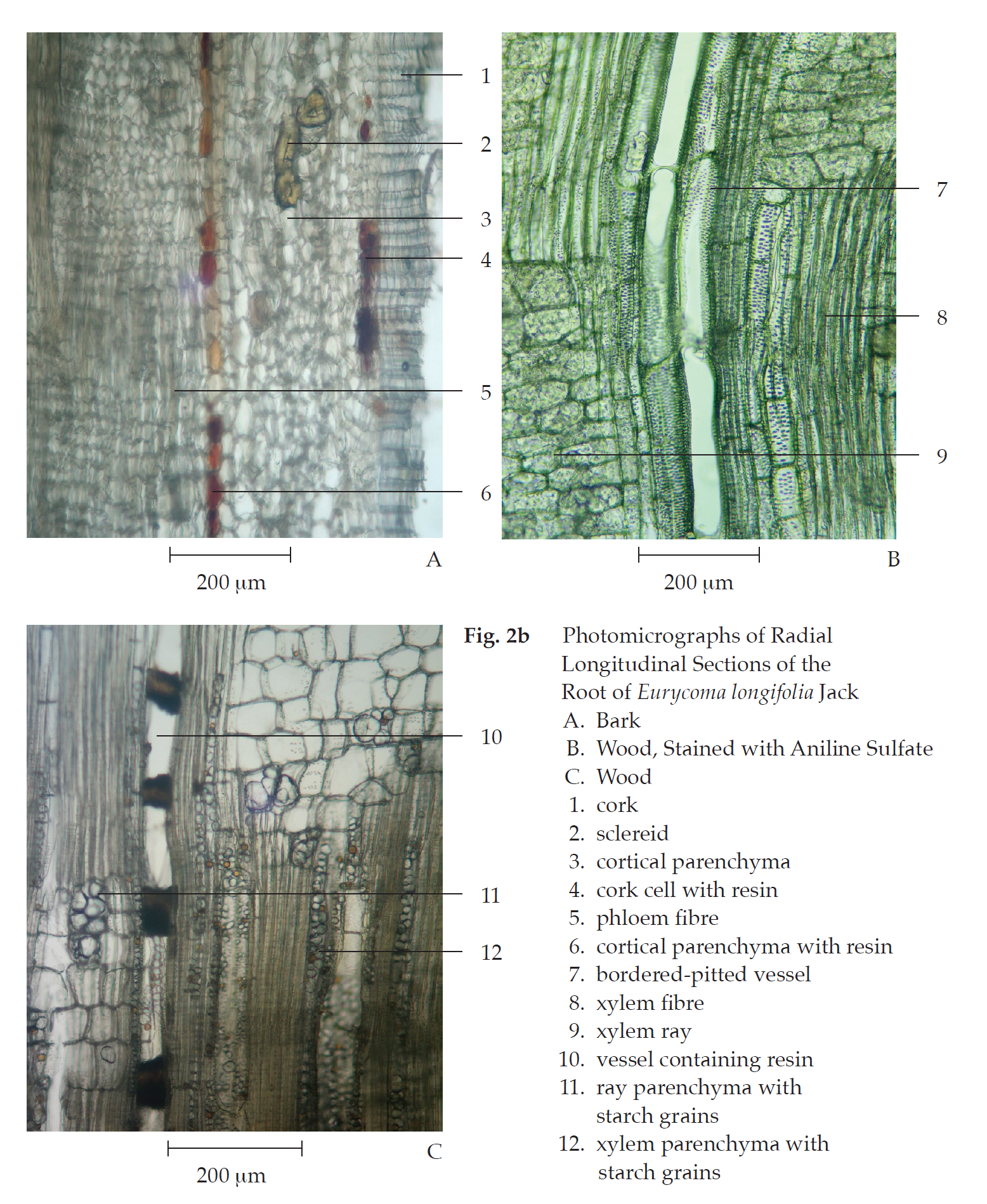
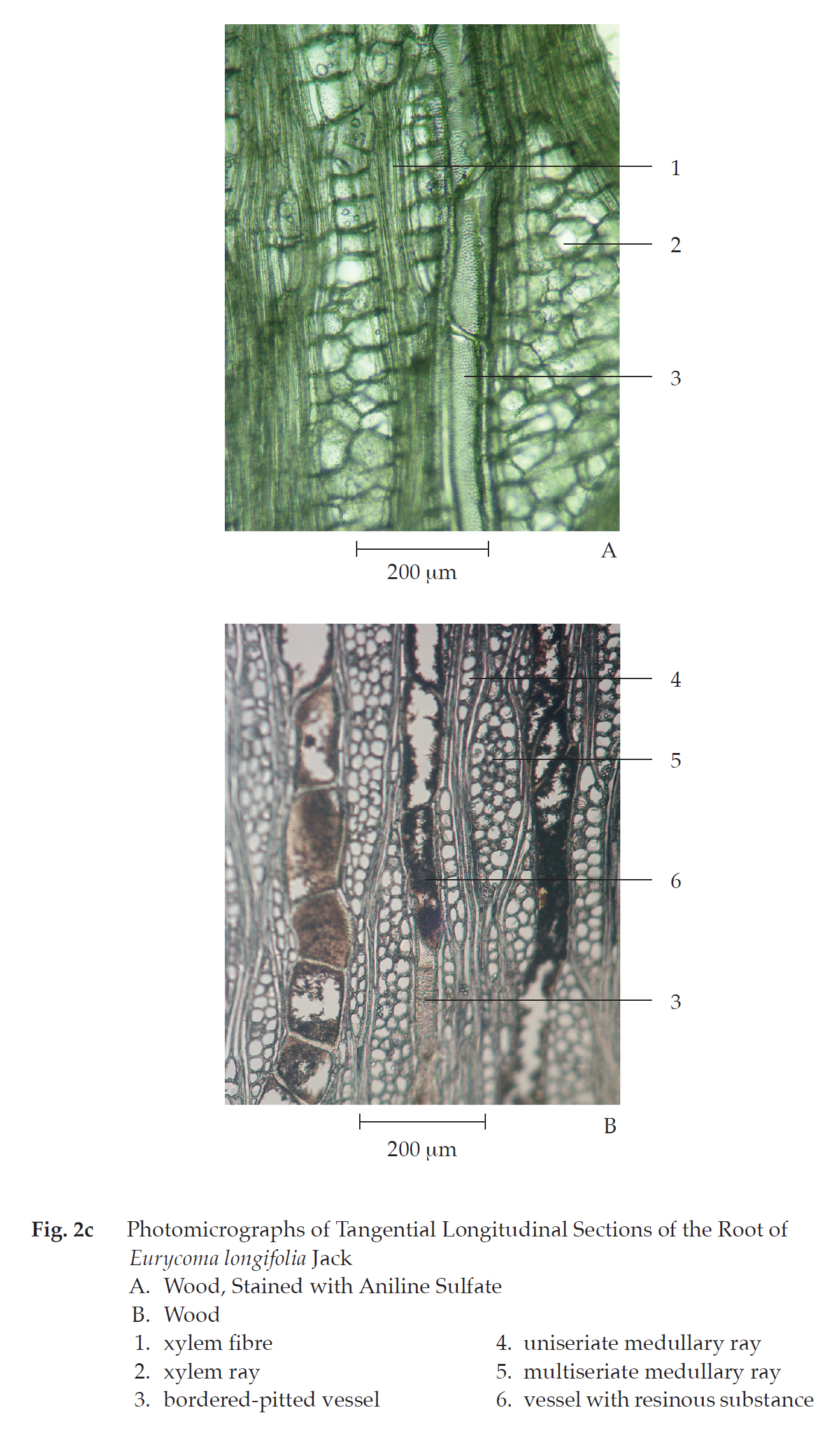
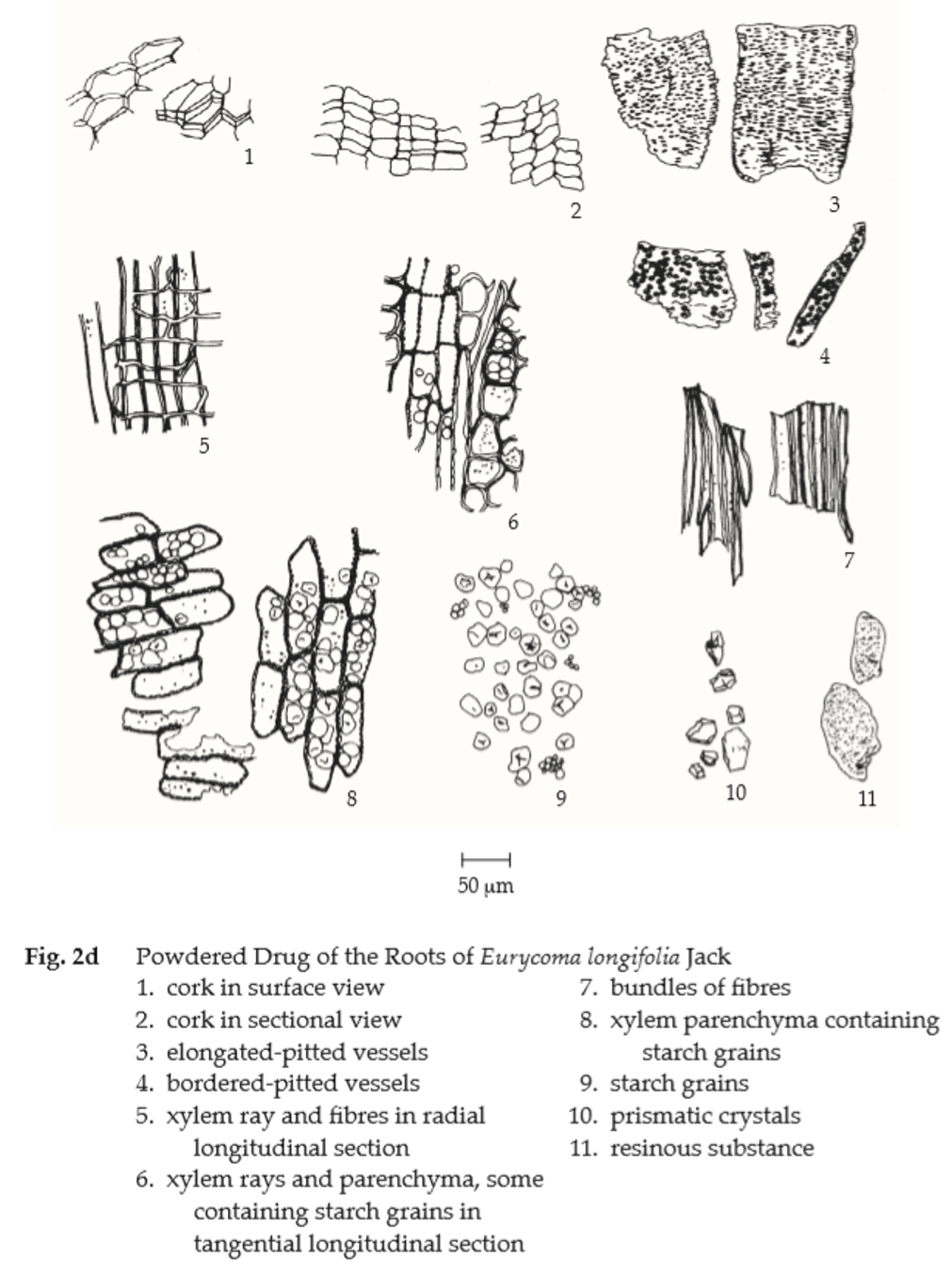
Radial and tangential longitudinal sections of the root show cork, cortex, phloem, xylem, and medullary ray. Cork, several layers of suberized rectangular cells, some containing reddish brown resinous substance. Cortex, thin-walled rectangular parenchyma cells, some of which with numerous starch grains, reddish brown resinous substance or prismatic crystals. Phloem, layers of rectangularly elongated parenchyma cells and fibres. Xylem, bordered-pitted vessels, some of which containing dark brown resinous substance, slightly lignified polygonal parenchyma, some of which containing starch grains, and fibres. Medullary ray in radial longitudinal view, rectangular phloem ray cells and xylem ray cells; in tangential longitudinal view, groups of round parenchyma cells, some of which containing starch grains.
Longjack Root in powder possesses the diagnostic microscopical characters of the unground drug. Various sizes of starch grains and medullary ray cells can be seen in abundant. Cork cells, large bordered-pitted vessels and prismatic crystals can also be observed.
Packaging and storage Longjack Root shall be kept in well-closed containers, protected from light, and stored in a dry place.
Identification
A. Reflux 1 g of the sample, in fine powder, with 10 mL of ethanol on a water-bath for 15 minutes and filter (solution 1). Evaporate 2 mL of solution 1 to dryness, dissolve the residue in 2 mL of acetic anhydride and slowly add 1 mL of sulfuric acid to form two layers, the upper layer changes to a brownish yellow colour and a brownish red ring is formed at the zone of contact.
B. To 2 mL of solution 1, add 1 to 2 drops of a 2 per cent w/v solution of 3,5-dinitrobenzoic acid in methanol, mix and add 1 to 2 drops of a 5.7 per cent w/v solution of potassium hydroxide in methanol: a brownish purple colour is produced.
C. Carry out the test as described in the “Thin-Layer Chromatography” (Appendix 3.1), using silica gel GF254 as the coating substance and a mixture of 85 volumes of ethyl acetate, 15 volumes of methanol and 0.1 volume of glacial acetic acid as the mobile phase and allowing the solvent front to ascend 10 cm above the line of application. Apply separately to the plate as bands of 10 mm, 5 μL each of the following solutions. Prepare solution (A) by refluxing 500 mg of the sample, in fine powder, with 20 mL of ethanol for 15 minutes, filtering and evaporating the filtrate to dryness under reduced pressure at 40°. Dissolve the residue in 2 ml of ethanol. For solution (B), dissolve 1 mg of eurycomanone in 2 mL of ethanol. After removal of the plate, allow it to dry in air and examine under ultraviolet light (254 nm), marking the quenching bands. The chromatogram obtained from solution (A) shows a quenching band (hRf value 53 to 56) corresponding to the eurycomanone band from solution (B) and several quenching bands are also observed. Subsequently examine the plate under ultraviolet light (366 nm) through the cut-off filter; several blue fluorescent bands are observed. Spray the plate with a 20 per cent v/v solution of sulfuric acid in ethanol and heat at 110° for 5 minutes; the band due to eurycomanone is brown. Other several brown and purple bands also appear (Table 1); see also Fig. 3.
Table 1 hRf Values of Components in Ethanolic Extract of the Roots of Eurycoma longifolia Jack
| Band | hRf Value | Detection | ||
| UV 254 | UV 366 | 20 Per Cent V/V Solution of Sulfuric Acid in Ethanol |
||
| 1 2 3 4* 5 6 7 8 9 10 11 |
8-10 11-16 27-29 53-56 73-75 77-79 79-81 84-86 90-92 95-96 96-99 |
- quenching - quenching - quenching - quenching quenching quenching - |
- blue light blue - light blue - light blue blue - - - |
brown - - brown - - - pale brown pale purple purple purple |
*eurycomanone
Loss on drying Not more than 8.0 per cent w/w after drying at 105° to constant weight (Appendix 4.15).
Foreign matter Not more than 2.0 per cent w/w (Appendix 7.2).
Acid-insoluble ash Not more than 2.0 per cent w/ w (Appendix 7.6).
Total ash Not more than 4.0 per cent w/w (Appendix 7.7).
Ethanol-soluble extractive Not less than 2.0 per cent w/w (Appendix 7.12).
Water-soluble extractive Not less than 7.0 per cent w/w (Appendix 7.12).
